On View
An Illuminating New Show Celebrates the Life and Art of Brigid Berlin, Daughter of High Society and Friend of Andy Warhol
Curated by Alison M. Gingeras, "The Heaviest" is currently on view at Vito Schnabel's downtown gallery.
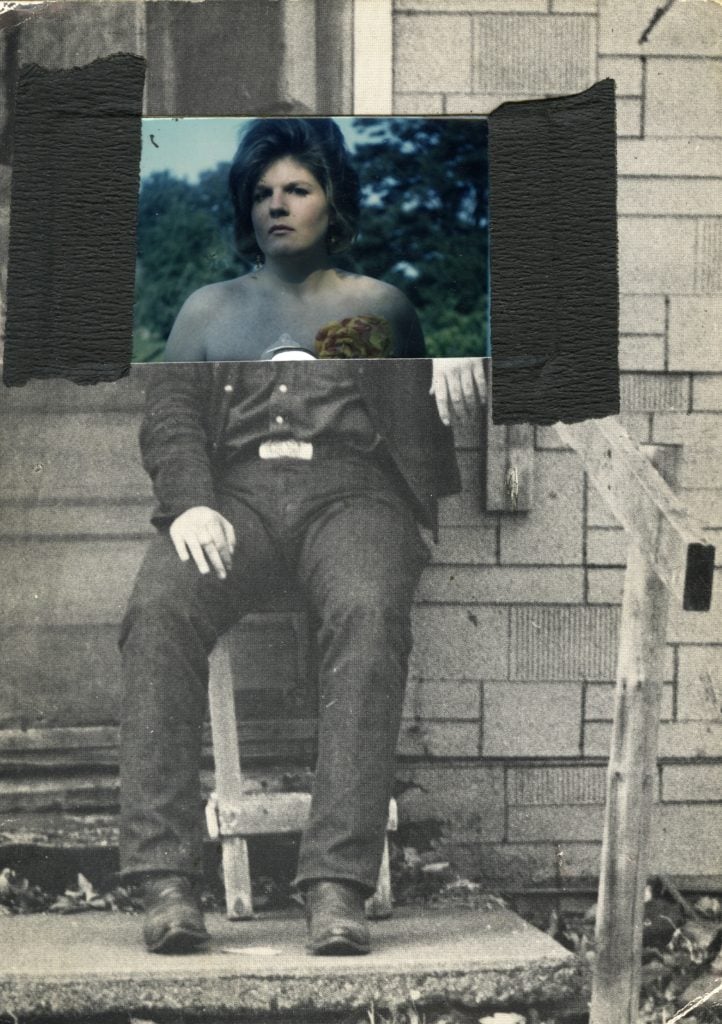
Curated by Alison M. Gingeras, "The Heaviest" is currently on view at Vito Schnabel's downtown gallery.

Katie White

Brigid Berlin was a debutante, a rebel, an artist, a muse.
She is not a familiar name to many, even today, but in the downtown demimonde of the 1960s and ‘70s, Berlin became a cult figure, famed as Andy Warhol’s rollicking Factory sidekick, his muse, and the star of his 1966 experimental film Chelsea Girls. She was also an intriguing artist in her own right, who many say picked up the Polaroid before Warhol himself, and was a collaborator with a number of the leading artistic names of her era. Berlin, who died in New York City in 2020 at the age of 80, was in many ways a consummate contradiction, and the scope of her heady, and at times fraught, life and legacy are still coming into focus.
Now, “The Heaviest,” a new exhibition at Vito Schnabel’s downtown space, curated by Alison M. Gingeras, is putting the spotlight on Berlin as an artist with a complex, ahead-of-her-time practice, and introducing her provocative legacy to a new generation. The exhibition is a dizzyingly intense portrait of a creative force, and follows from Berlin’s childhood as a daughter of New York high society, through her famed years in Warhol’s Factory circle, to her independent artistic career and exhibitions, and well into the latter years of her life when she returned to the monied circles of her childhood. This full-circle presentation brings together Berlin’s work in Polaroids, audio recordings, and even needlepoint.
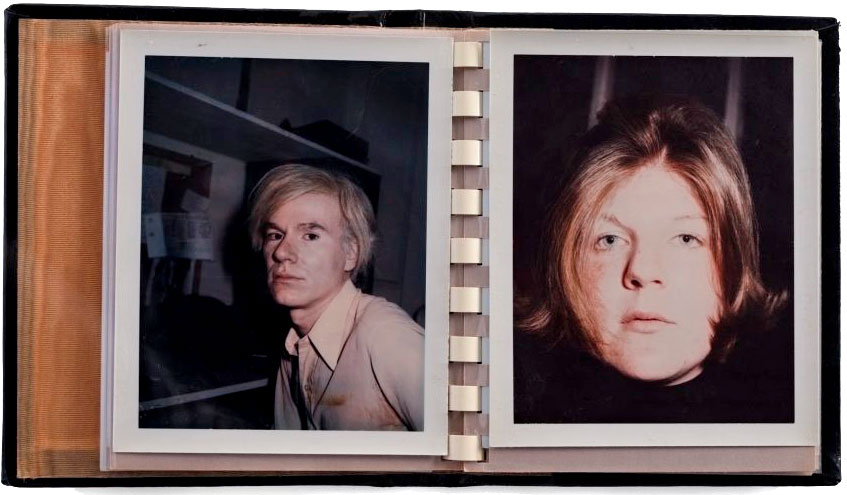
Brigid Berlin, Mr. and Mrs. Brigid Pork. © Vincent Fremont/Vincent Fremont Enterprises, Inc. All rights reserved.
Much of the work included in the show is on view for the first time; Gingeras spent several years planning the exhibition, tracking down materials in artist archives and through Berlin’s estate. The idea for the exhibition first sparked while Gingeras was writing an essay for the 2019 catalog Warhol’s Women. “I was researching these women who were major agents of creative exchange in Warhol’s life, and I realized how much of Brigid’s own contributions as an artist have been read through the lens of Warhol. It rubbed me the wrong way,” she explained. “This exhibition really became an opportunity to look at her in a holistic way both in a biographical sense and as a deeper dive into her relationships and her position in the art world especially in the 1970s.”
Berlin was born in 1939 the daughter of sought-after socialite Muriel “Honey” Johnson and Richard E. Berlin, the chairman of Hearst’s media empire for over three decades. Her father’s powerful position placed the family at the height of upper-crust society—Nelson Rockefeller, Richard Nixon, and the Windsors were all family friends who sought his counsel. But Berlin’s want-for-nothing childhood was anything but idyllic. The exhibition begins with staged saccharine childhood photographs and Christmas cards of Berlin and her sister. These perfected images are juxtaposed with vitrines of letters exchanged between Berlin, at boarding school, and her mother; often wrenching, the letters document her mother’s merciless scolding of Berlin over her weight (her mother infamously fed Berlin amphetamines as a child in an attempt to control her figure), but also hint at Berlin’s rebellious nature. One letter from Berlin’s schoolmaster details a night of drinking gone awry in sordid and comical detail.
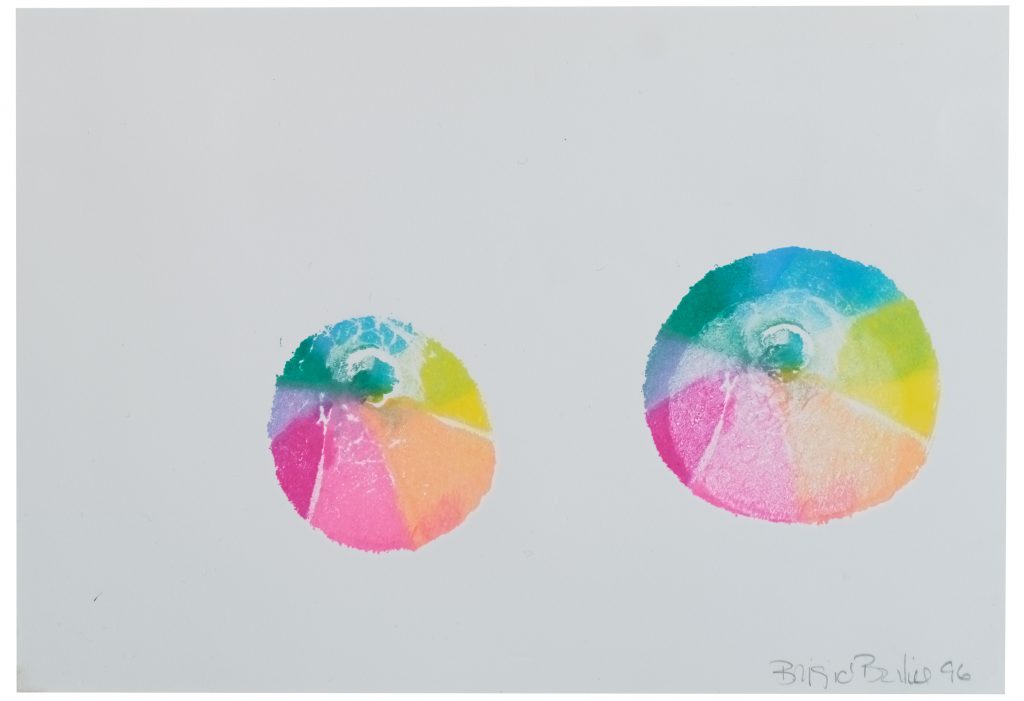
Brigid Berlin, Untitled (Tit Print) (1996). © Vincent Fremont/Vincent Fremont Enterprises, Inc. All rights reserved.
“Her family’s shaming around her body was the catalyst that catapulted her into the so-called rebellion that brought her to the doorstep of the Factory,” Gingeras said, walking through the exhibition.
The Factory and Warhol, the father of Pop, are certainly present in “The Heaviest” but here Warhol is pictured through the eyes of Berlin, rather than the other way around. A selection of Berlin’s many thematically compiled photo books of Polaroids is on view, including one with “Mr & Mrs. Brigid Pork” embossed on its cover, a reference to the pet names the friends kept for each other. In this book, Berlin and Warhol are presented in photographs side by side, a creative dyad rather than an artist and muse.
But while the Factory can certainly be felt, it’s Berlin as an autonomous artist who is the exhibition’s primary focus. Perhaps the birthright of her high-society background, Berlin, the exhibition makes clear, had a way of permeating many worlds. While Warhol might have been her most famed companion, she was embraced by the hard-drinking macho “heavies” of the art world and counted Willem de Kooning, John Chamberlain, Larry Rivers, Donald Judd, Richard Serra, James Rosenquist, and Brice Marden among her friends. These artists, too, all appear in her Polaroid photo books, and their friendships are detailed in exchanged letters, postcards, as well as in portraits of Berlin herself, including one by Ray Johnson, on view in the show.
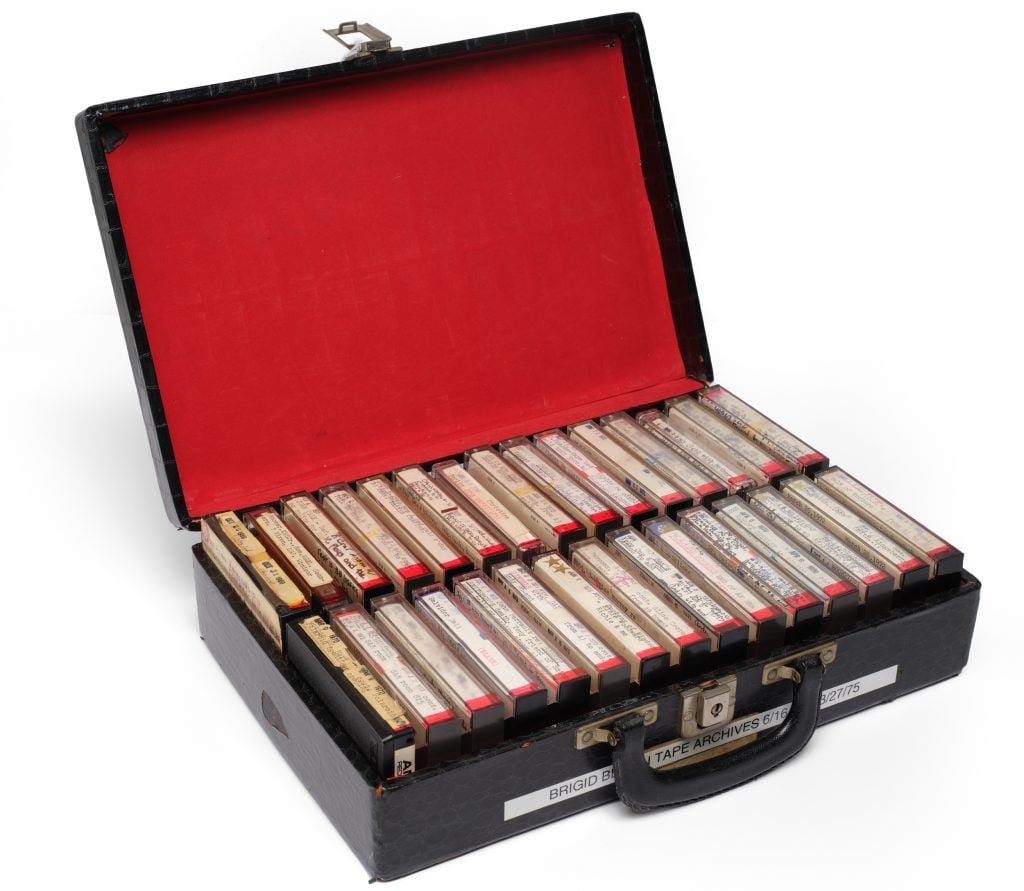
Cassette tapes from Brigid Berlin Audio Archive. © Rob Vaczy and Pat Hackett. All rights reserved.
Though Berlin often focused her lens outward, when she looked toward herself her work feels especially satisfying. Among the most evocative works in the exhibition are Berlin’s so-called “tit prints,” which, as the name would suggest, are colorful prints the artist created using her breasts. For a figure who was so often judged, these prints feel wonderfully embodied. “Body positivity did not exist then and she really brazenly embraced her body as a creative tool,” Gingeras explained in conversation.
Berlin’s fascination with the body expanded beyond her own, however, and certainly the most irreverent work, and outright funny work in the exhibition is her infamous “Cock Book.” Made between 1968 and 1974, Berlin carried around a notebook embossed with “Topical Bible” on the cover, and asked mainly male artists to depict their penises in its pages. Filled with drawings, photographs, and collages, the book’s numerous contributors include Jean-Michel Basquiat, Dennis Hopper, Cy Twombly, James Rosenquist, Ray Johnson, Cecil Beaton, and Robert Smithson, among dozens of other familiar names.
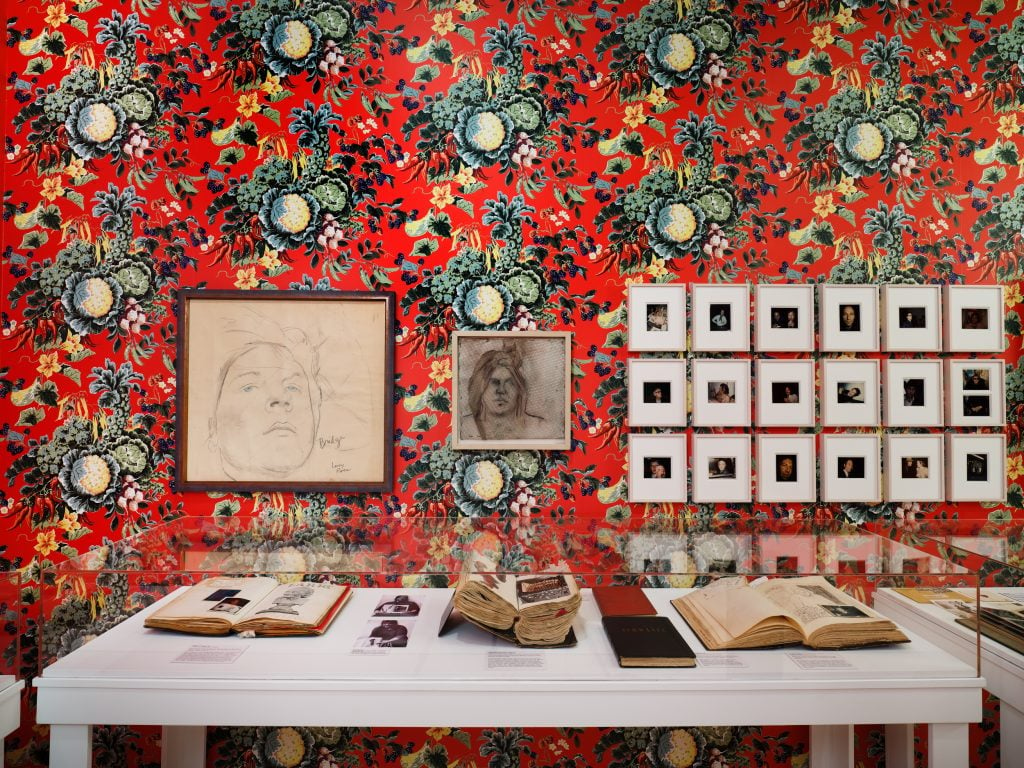
Installation view of “Brigid Berlin: The Heaviest,” curated by Alison M. Gingeras. Photo: Argenis Apolinario. Courtesy Vito Schnabel Gallery.
While the ephemera of these friendships function to locate Berlin at the heart of the artistic scene of the era, the exhibition is right to point out that her recognition as a bonafide artist came from dealers, as well. In 1970, Berlin was the subject of a solo exhibition at the famed Heiner Friedrich Gallery in Cologne, Germany—her first solo and one that showcased her audio tapes and Polaroid photographs. “The Heaviest” is remarkably the first exhibition since that seminal show to present these recordings, which encompass calls and conversations between Berlin and those close to her. The recordings are startlingly transportive. In one, Berlin’s mother lambasts her for her association with the Factory milieu, accusing Berlin of using drugs. In another, Warhol pleads with Berlin, when she says she’s torn up her Polaroids, and he offers to pay her a penny a piece for them (and then, when she hesitates, three pennies). These tidbits are oddly prescient of our contemporary fixation on reality entertainment, and wholly absorbing.
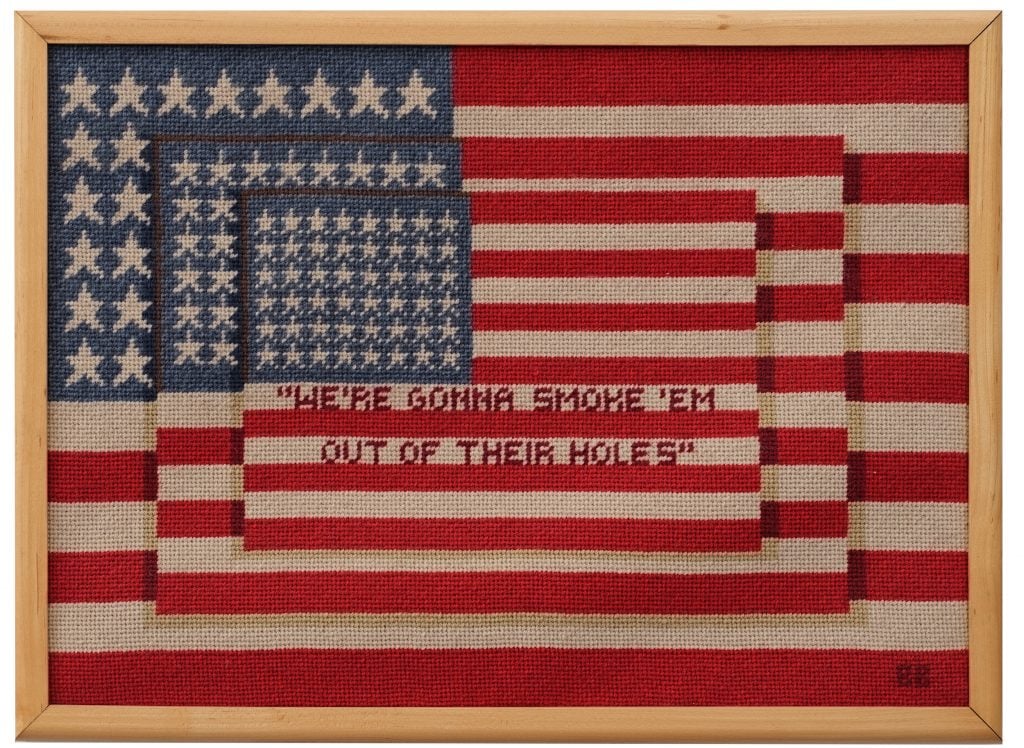
Brigid Berlin, Untitled (Jasper Johns Flag) (ca. 2002). © Vincent Fremont/Vincent Fremont Enterprises, Inc. All rights reserved. Collection of Vincent and Shelly Fremont, New York.
Perhaps what makes Berlin so intriguing as a creative force is her simultaneous adherence to and transcendence of the norms of her time. While she eschewed her conservative childhood, she sought the approval of male artists, what Berlin calls her “internalized misogyny.” Her political views could be anything but polite. Later in her life, Berlin fully abandoned the downtown sphere, moving into an uptown apartment. A bright coral wallpaper lines the walls of the gallery—it’s a custom recreation of the same wallpaper that decorated Berlin’s home—and hints at a country club conservatism that is garish in its own unique way.
In these later decades, Berlin didn’t give up art-making entirely. Among the highlights of the show are several needlepoint pillowcases she made in the early 2000s—some recreating New York Post covers, covers which Berlin said reminded her of her father; another mixes Jasper Johns’s Flags with jingoistic language that can feel as American as a can of Campbell’s soup—the darker side of the American dream. The exhibition closes with a collection of artistic tributes to Berlin, from Kate Simon’s striking 2008 portrait of the artist to a recent painting by Elisabetta Zangrandi—the interpretations are varied and appear like offerings left at the reliquary of a mythic creative life.